TOYOTA MIRAI 2016 1.G Owners Manual
Manufacturer: TOYOTA, Model Year: 2016, Model line: MIRAI, Model: TOYOTA MIRAI 2016 1.GPages: 464, PDF Size: 8.05 MB
Page 321 of 464
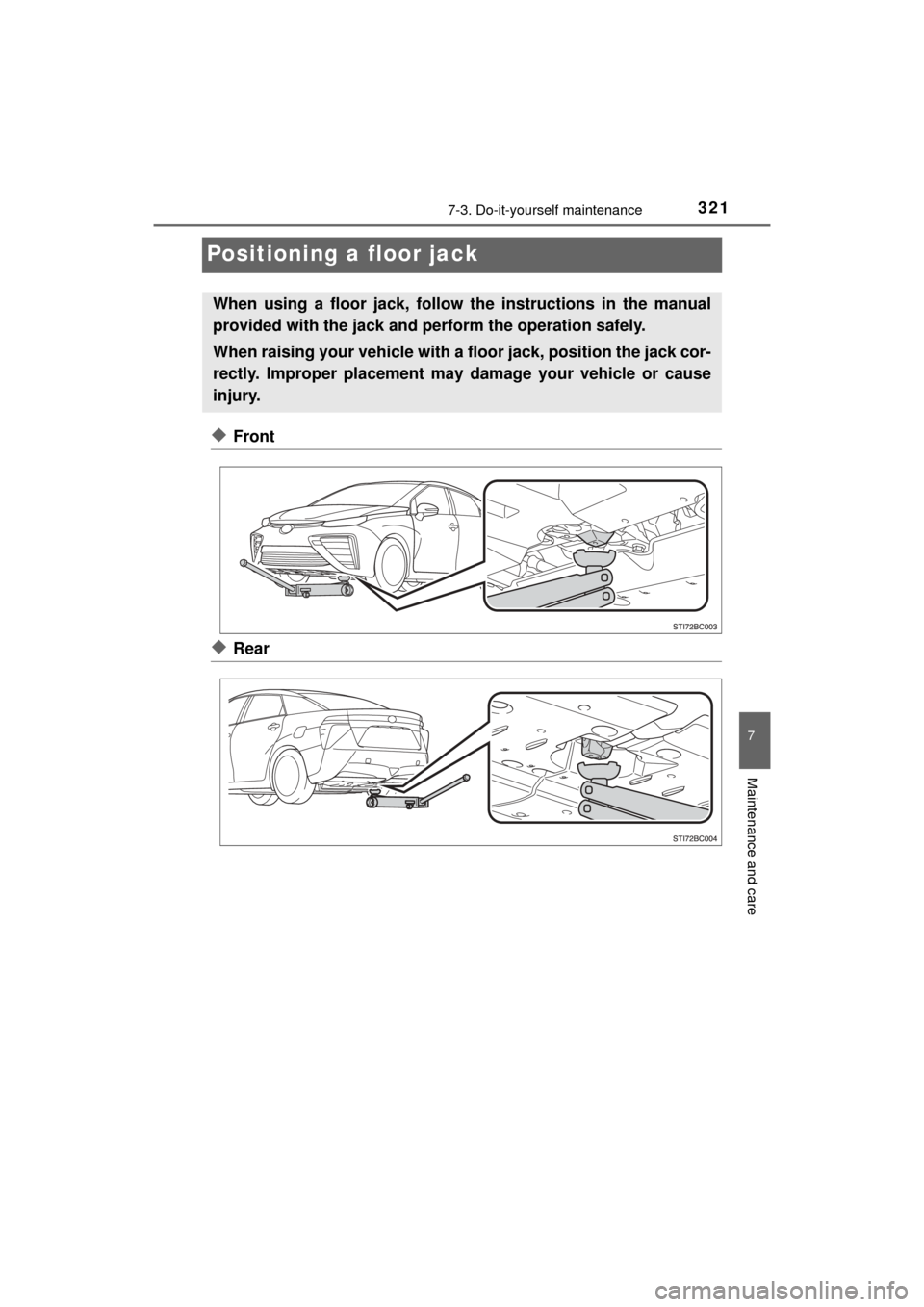
3217-3. Do-it-yourself maintenance
MIRAI_OM_USA_OM62004U
7
Maintenance and care
Positioning a floor jack
◆Front
◆Rear
When using a floor jack, follow the instructions in the manual
provided with the jack and perform the operation safely.
When raising your vehicle with a floor jack, position the jack cor-
rectly. Improper placement may damage your vehicle or cause
injury.
Page 322 of 464
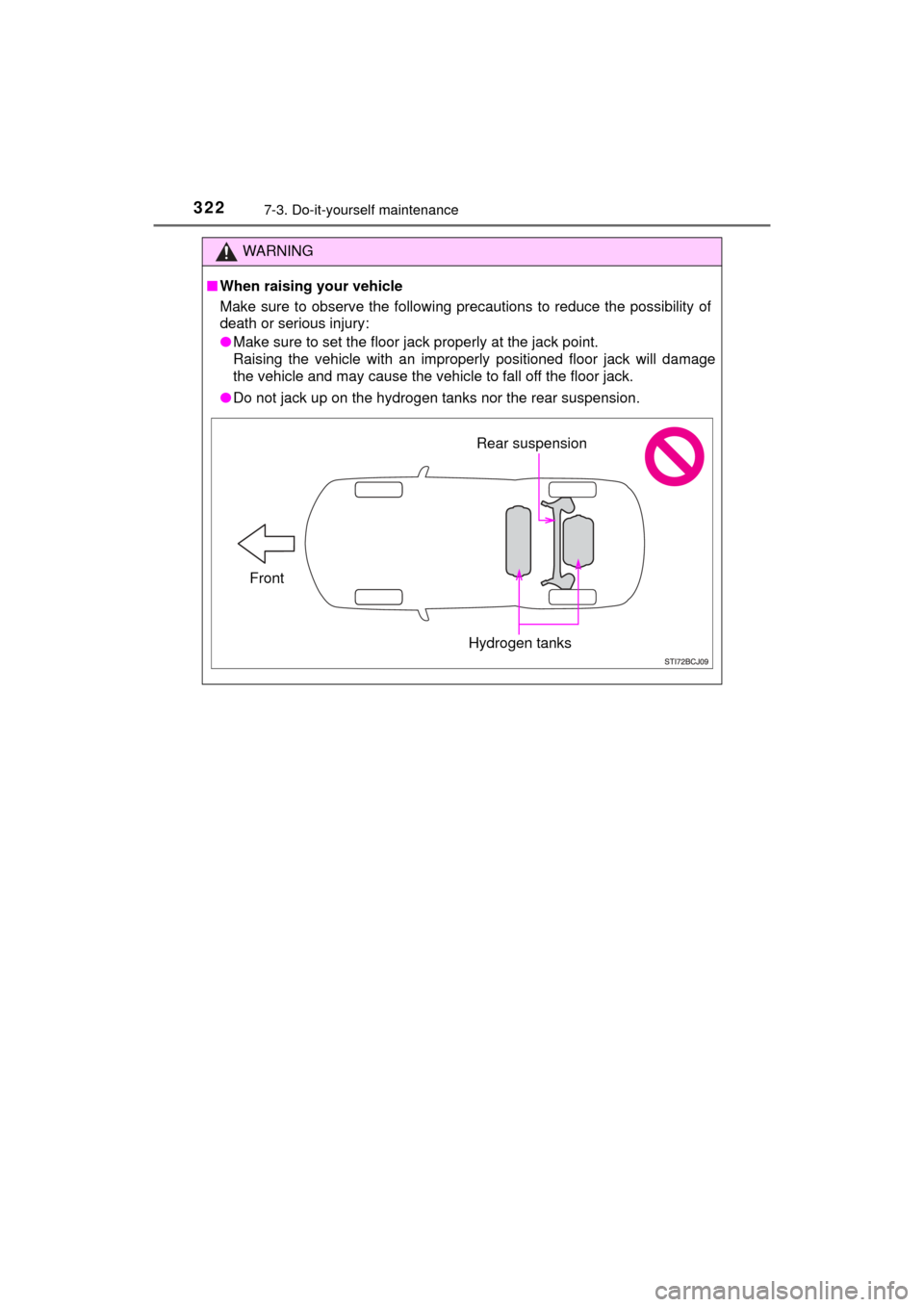
3227-3. Do-it-yourself maintenance
MIRAI_OM_USA_OM62004U
WARNING
■When raising your vehicle
Make sure to observe the following precautions to reduce the possibility of
death or serious injury:
●Make sure to set the floor jack properly at the jack point.
Raising the vehicle with an improperly positioned floor jack will damage
the vehicle and may cause the vehicle to fall off the floor jack.
● Do not jack up on the hydrogen tanks nor the rear suspension.
Rear suspension
Hydrogen tanks
Front
Page 323 of 464
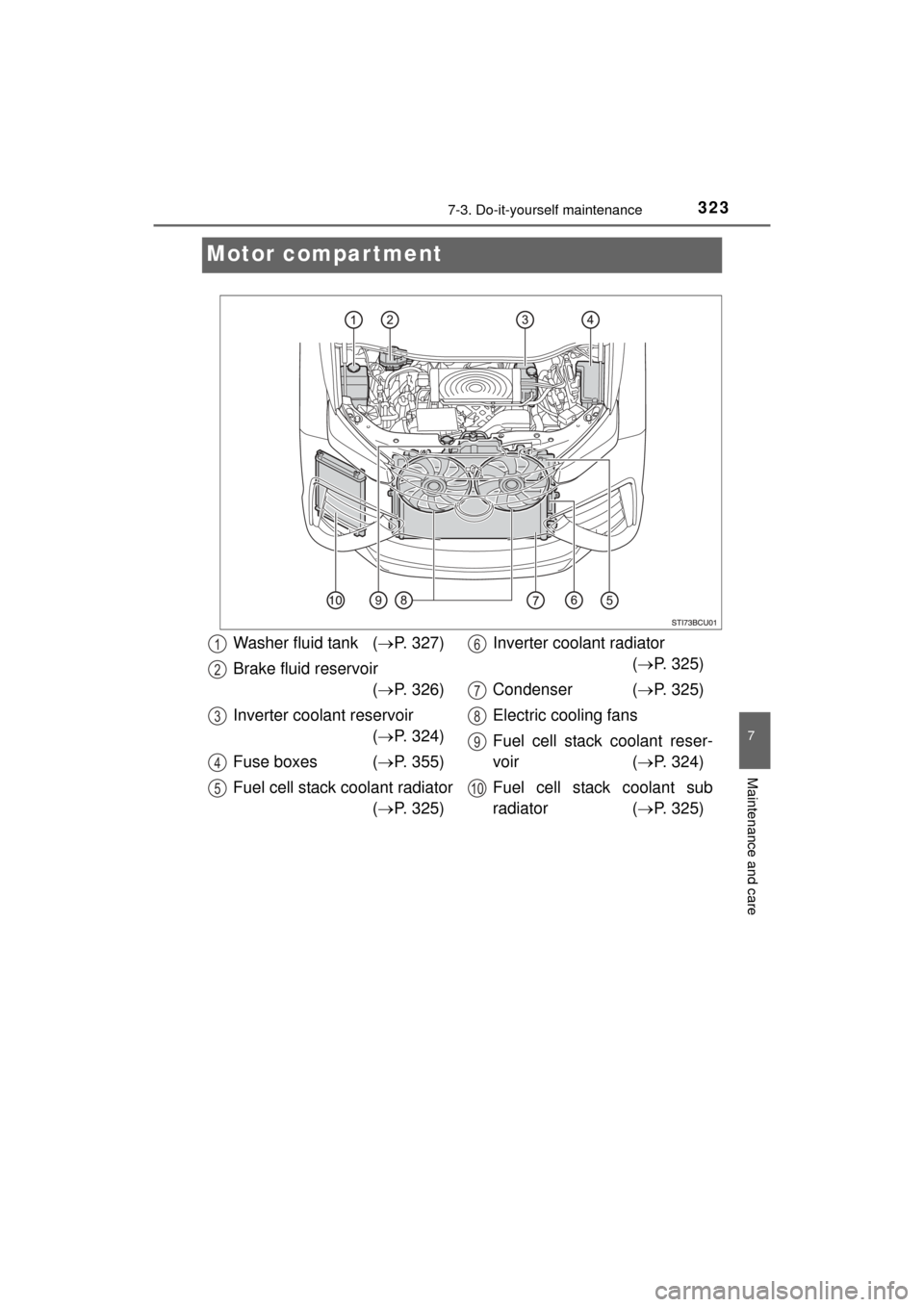
3237-3. Do-it-yourself maintenance
MIRAI_OM_USA_OM62004U
7
Maintenance and care
Motor compartment
Washer fluid tank (P. 327)
Brake fluid reservoir ( P. 326)
Inverter coolant reservoir ( P. 324)
Fuse boxes ( P. 355)
Fuel cell stack coolant radiator ( P. 325) Inverter coolant radiator
( P. 325)
Condenser ( P. 325)
Electric cooling fans
Fuel cell stack coolant reser-
voir ( P. 324)
Fuel cell stack coolant sub
radiator ( P. 325)1
2
3
4
5
6
7
8
9
10
Page 324 of 464
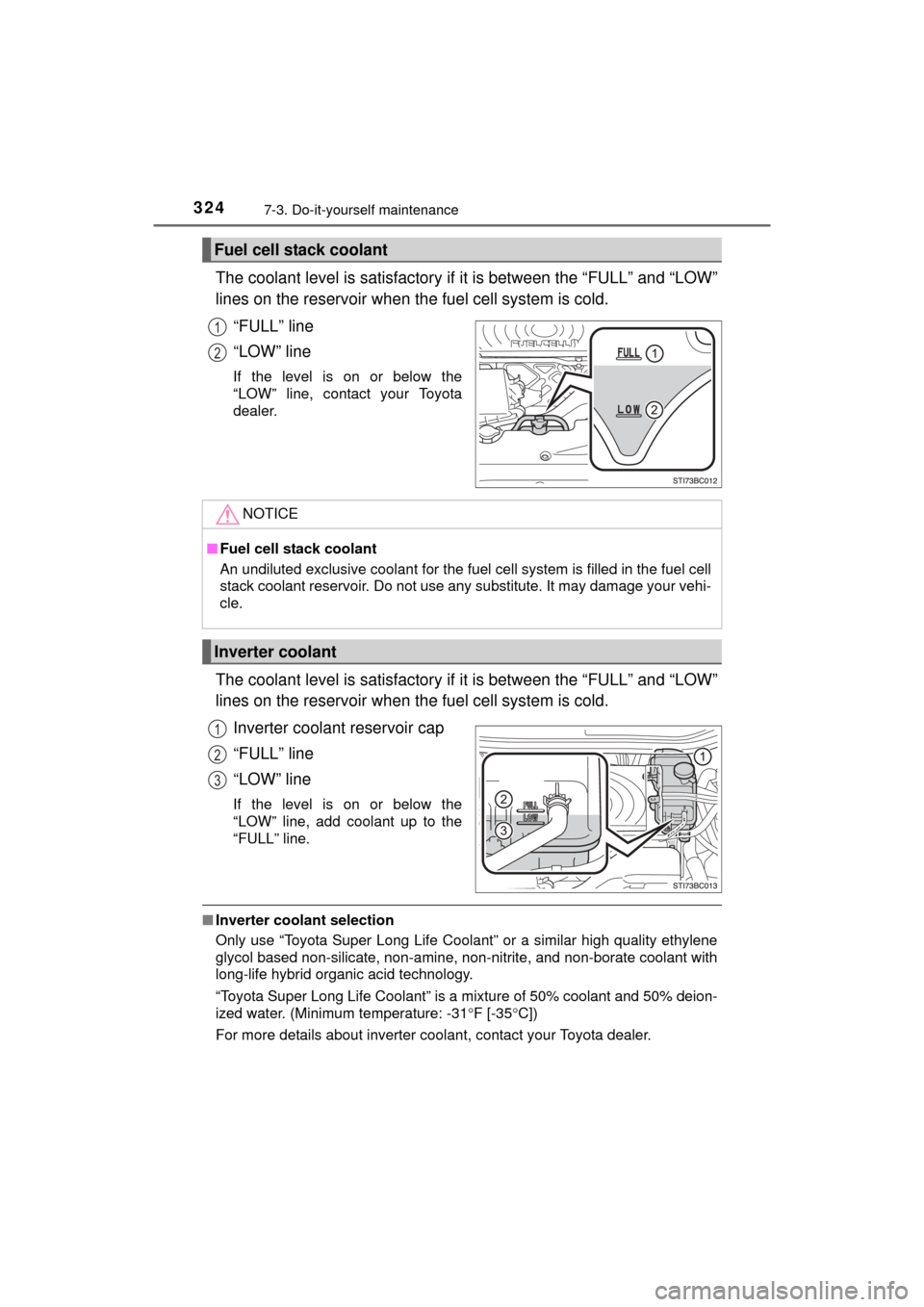
3247-3. Do-it-yourself maintenance
MIRAI_OM_USA_OM62004U
The coolant level is satisfactory if it is between the “FULL” and “LOW”
lines on the reservoir when the fuel cell system is cold.“FULL” line
“LOW” line
If the level is on or below the
“LOW” line, contact your Toyota
dealer.
The coolant level is satisfactory if it is between the “FULL” and “LOW”
lines on the reservoir when the fuel cell system is cold.Inverter coolant reservoir cap
“FULL” line
“LOW” line
If the level is on or below the
“LOW” line, add coolant up to the
“FULL” line.
■Inverter coolant selection
Only use “Toyota Super Long Life Coolant” or a similar high quality ethylene
glycol based non-silicate, non-amine, non-nitrite, and non-borate coolant with
long-life hybrid organic acid technology.
“Toyota Super Long Life Coolant” is a mixture of 50% coolant and 50% deion-
ized water. (Minimum temperature: -31 F [-35 C])
For more details about inverter coolant, contact your Toyota dealer.
Fuel cell stack coolant
1
2
NOTICE
■ Fuel cell stack coolant
An undiluted exclusive coolant for the fuel cell system is filled in the fuel cell
stack coolant reservoir. Do not use any substitute. It may damage your vehi-
cle.
Inverter coolant
1
2
3
Page 325 of 464
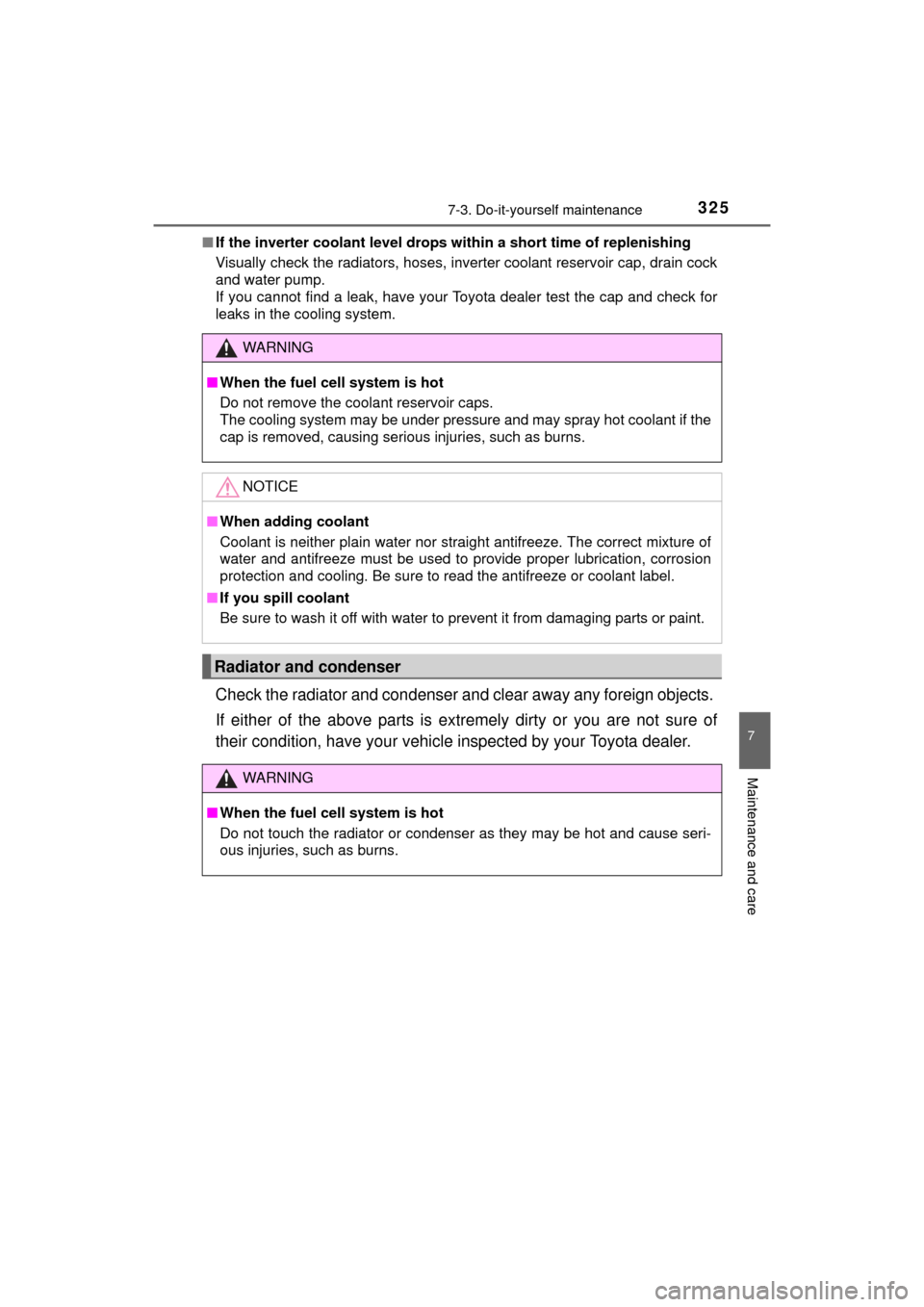
3257-3. Do-it-yourself maintenance
MIRAI_OM_USA_OM62004U
7
Maintenance and care
■If the inverter coolant level drops within a short time of replenishing
Visually check the radiators, hoses, inverter coolant reservoir cap, drain cock
and water pump.
If you cannot find a leak, have your Toyota dealer test the cap and check for
leaks in the cooling system.
Check the radiator and condenser an d clear away any foreign objects.
If either of the above parts is ex tremely dirty or you are not sure of
their condition, have yo ur vehicle inspected by your Toyota dealer.
WARNING
■When the fuel cell system is hot
Do not remove the coolant reservoir caps.
The cooling system may be under pressure and may spray hot coolant if the
cap is removed, causing serious injuries, such as burns.
NOTICE
■When adding coolant
Coolant is neither plain water nor straight antifreeze. The correct mixture of
water and antifreeze must be used to provide proper lubrication, corrosion
protection and cooling. Be sure to read the antifreeze or coolant label.
■ If you spill coolant
Be sure to wash it off with water to prevent it from damaging parts or paint.
Radiator and condenser
WARNING
■When the fuel cell system is hot
Do not touch the radiator or condenser as they may be hot and cause seri\
-
ous injuries, such as burns.
Page 326 of 464
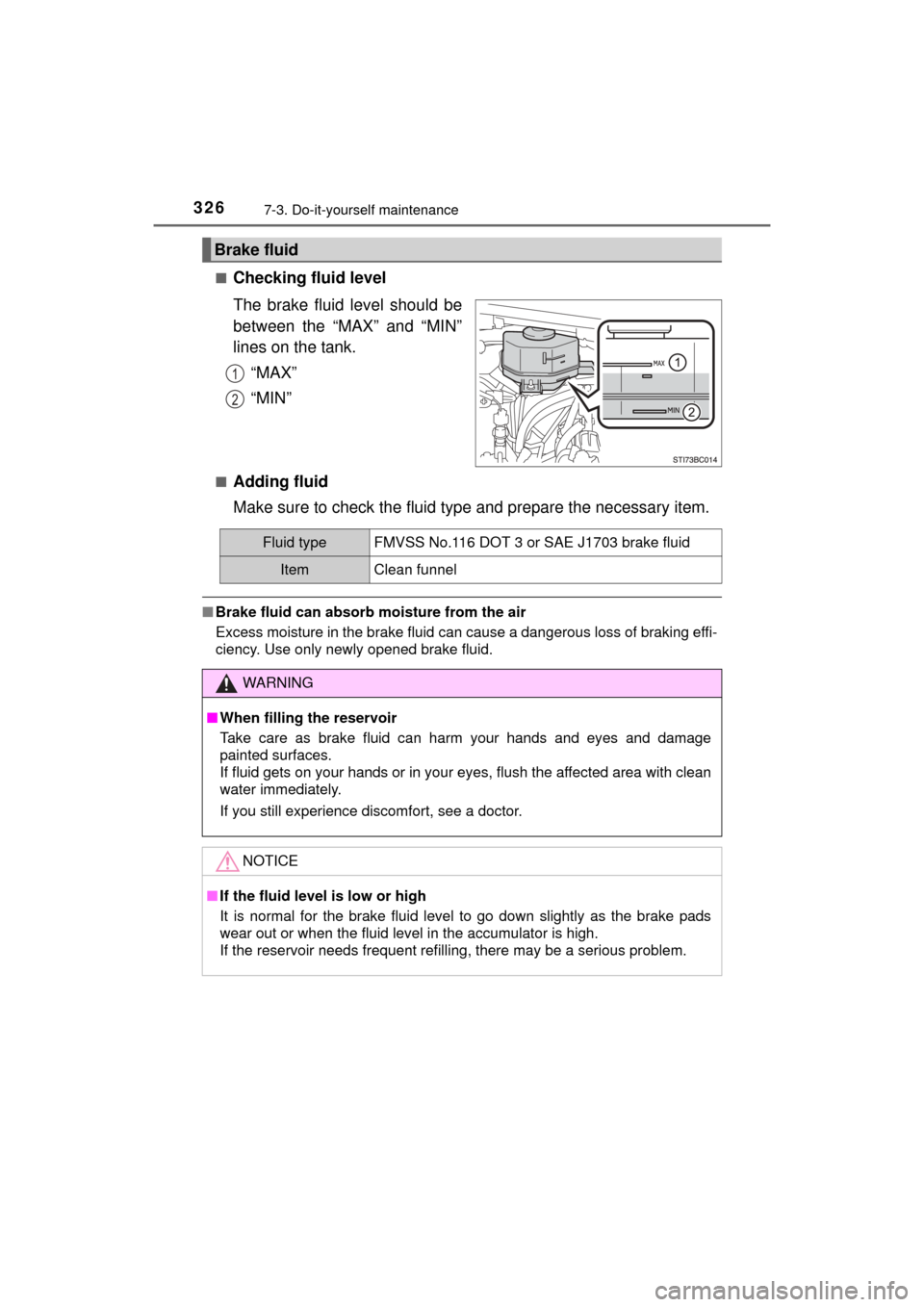
3267-3. Do-it-yourself maintenance
MIRAI_OM_USA_OM62004U■
Checking fluid level
The brake fluid level should be
between the “MAX” and “MIN”
lines on the tank.
“MAX”
“MIN”
■Adding fluid
Make sure to check the fluid ty pe and prepare the necessary item.
■Brake fluid can absorb moisture from the air
Excess moisture in the brake fluid can cause a dangerous loss of braking effi-
ciency. Use only newly opened brake fluid.
Brake fluid
1
2
Fluid typeFMVSS No.116 DOT 3 or SAE J1703 brake fluid
ItemClean funnel
WARNING
■When filling the reservoir
Take care as brake fluid can harm your hands and eyes and damage
painted surfaces.
If fluid gets on your hands or in your eyes, flush the affected area with clean
water immediately.
If you still experience discomfort, see a doctor.
NOTICE
■If the fluid level is low or high
It is normal for the brake fluid level to go down slightly as the brake pads
wear out or when the fluid level in the accumulator is high.
If the reservoir needs frequent refilling, there may be a serious problem.
Page 327 of 464
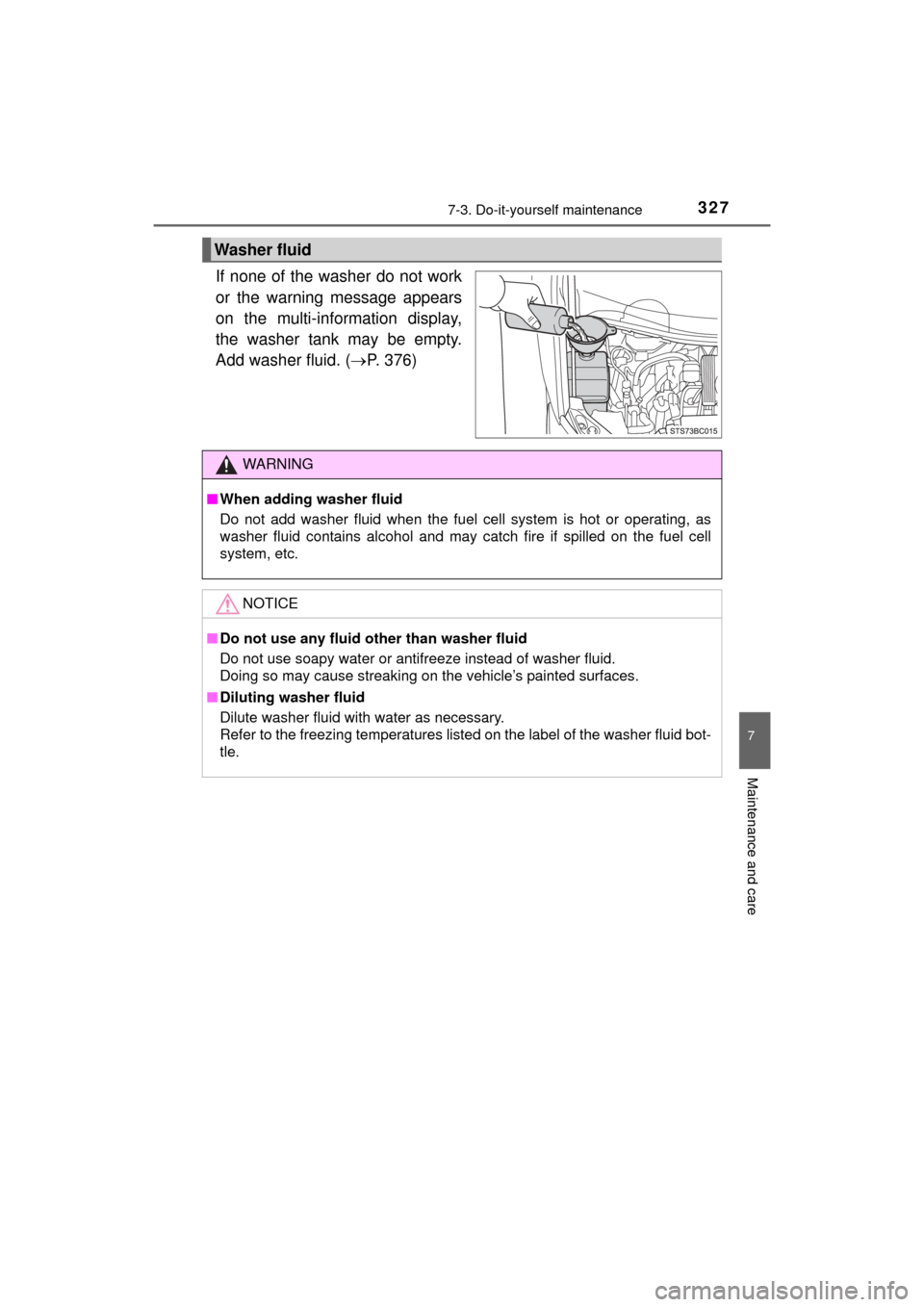
3277-3. Do-it-yourself maintenance
MIRAI_OM_USA_OM62004U
7
Maintenance and care
If none of the washer do not work
or the warning message appears
on the multi-information display,
the washer tank may be empty.
Add washer fluid. (P. 376)
Washer fluid
WARNING
■When adding washer fluid
Do not add washer fluid when the fuel cell system is hot or operating, as
washer fluid contains alcohol and may catch fire if spilled on the fuel cell
system, etc.
NOTICE
■Do not use any fluid other than washer fluid
Do not use soapy water or antifreeze instead of washer fluid.
Doing so may cause streaking on the vehicle’s painted surfaces.
■ Diluting washer fluid
Dilute washer fluid with water as necessary.
Refer to the freezing temperatures listed on the label of the washer fluid bot-
tle.
Page 328 of 464
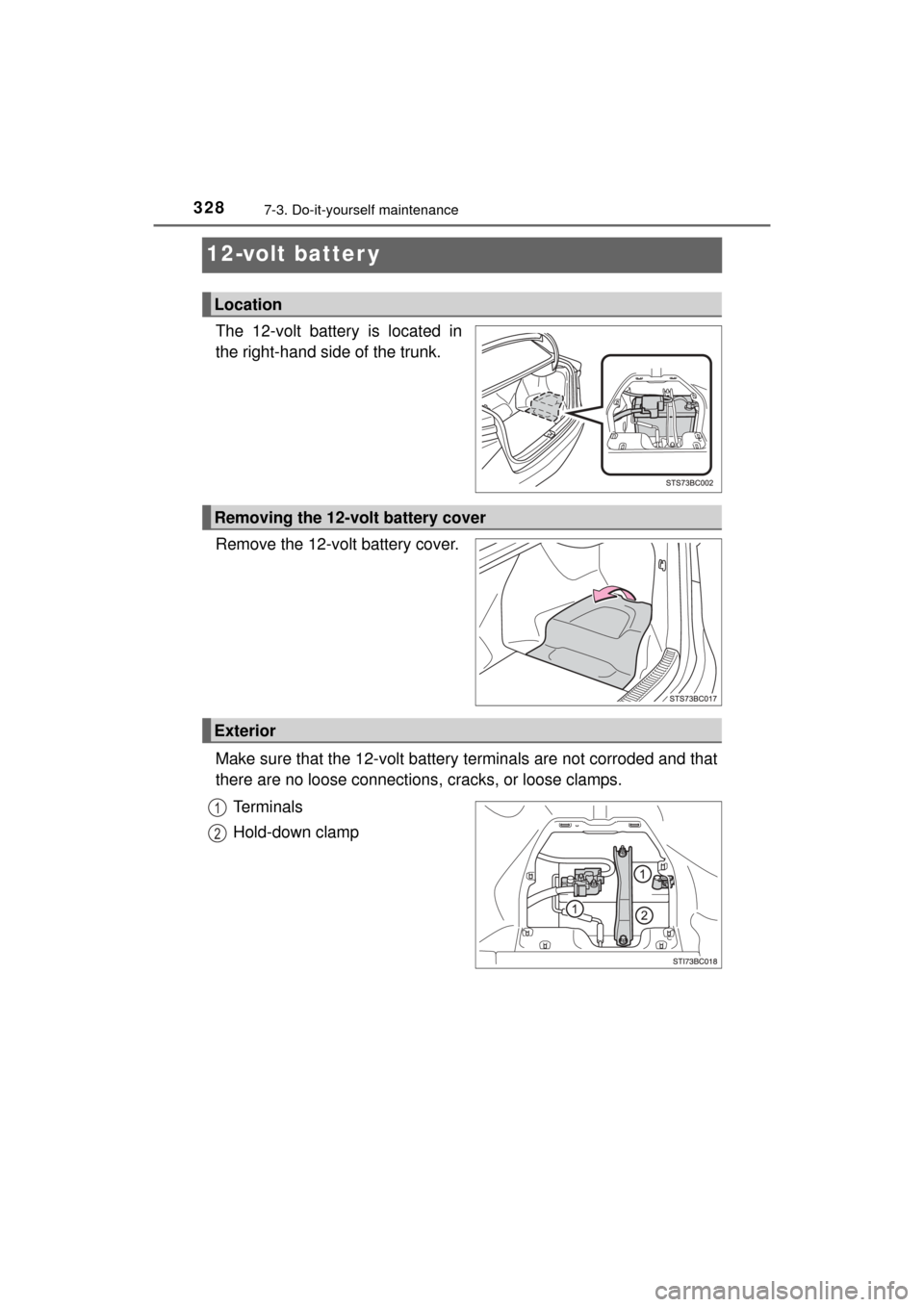
3287-3. Do-it-yourself maintenance
MIRAI_OM_USA_OM62004U
12-volt batter y
The 12-volt battery is located in
the right-hand side of the trunk.
Remove the 12-volt battery cover.
Make sure that the 12-volt battery terminals are not corroded and that
there are no loose connections, cracks, or loose clamps.
Terminals
Hold-down clamp
Location
Removing the 12-volt battery cover
Exterior
1
2
Page 329 of 464
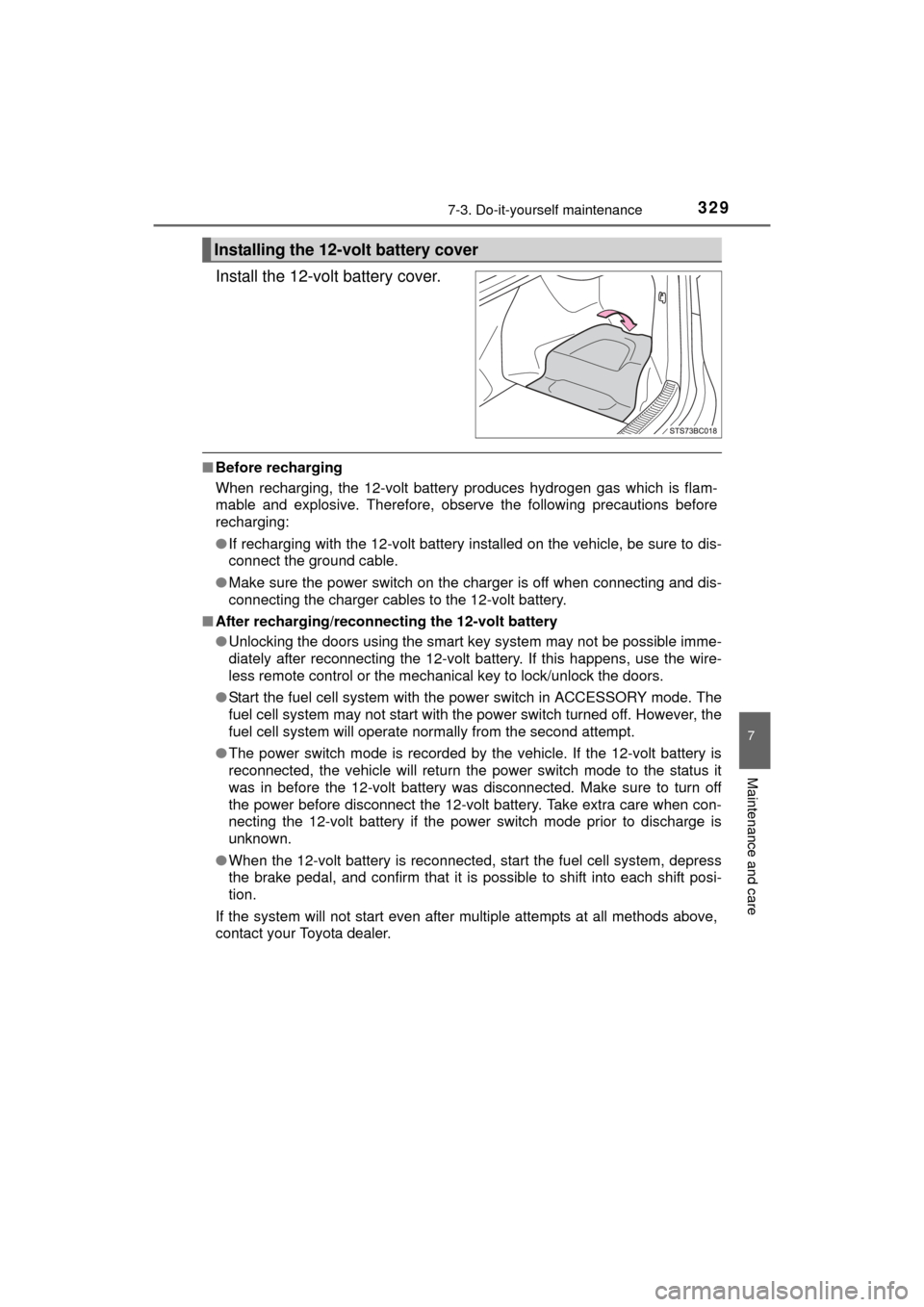
3297-3. Do-it-yourself maintenance
MIRAI_OM_USA_OM62004U
7
Maintenance and care
Install the 12-volt battery cover.
■Before recharging
When recharging, the 12-volt battery produces hydrogen gas which is flam-
mable and explosive. Therefore, observe the following precautions before
recharging:
●If recharging with the 12-volt battery installed on the vehicle, be sure to dis-
connect the ground cable.
● Make sure the power switch on the charger is off when connecting and dis-
connecting the charger cables to the 12-volt battery.
■ After recharging/reconnecting the 12-volt battery
●Unlocking the doors using the smart key system may not be possible imme-
diately after reconnecting the 12-volt battery. If this happens, use the wire-
less remote control or the mechanical key to lock/unlock the doors.
● Start the fuel cell system with the power switch in ACCESSORY mode. The
fuel cell system may not start with the power switch turned off. However, the
fuel cell system will operate normally from the second attempt.
● The power switch mode is recorded by the vehicle. If the 12-volt battery is
reconnected, the vehicle will return the power switch mode to the status it
was in before the 12-volt battery was disconnected. Make sure to turn off
the power before disconnect the 12-volt battery. Take extra care when con-
necting the 12-volt battery if the power switch mode prior to discharge is
unknown.
● When the 12-volt battery is reconnected, start the fuel cell system, depress
the brake pedal, and confirm that it is possible to shift into each shift posi-
tion.
If the system will not start even after multiple attempts at all methods above,
contact your Toyota dealer.
Installing the 12-volt battery cover
Page 330 of 464
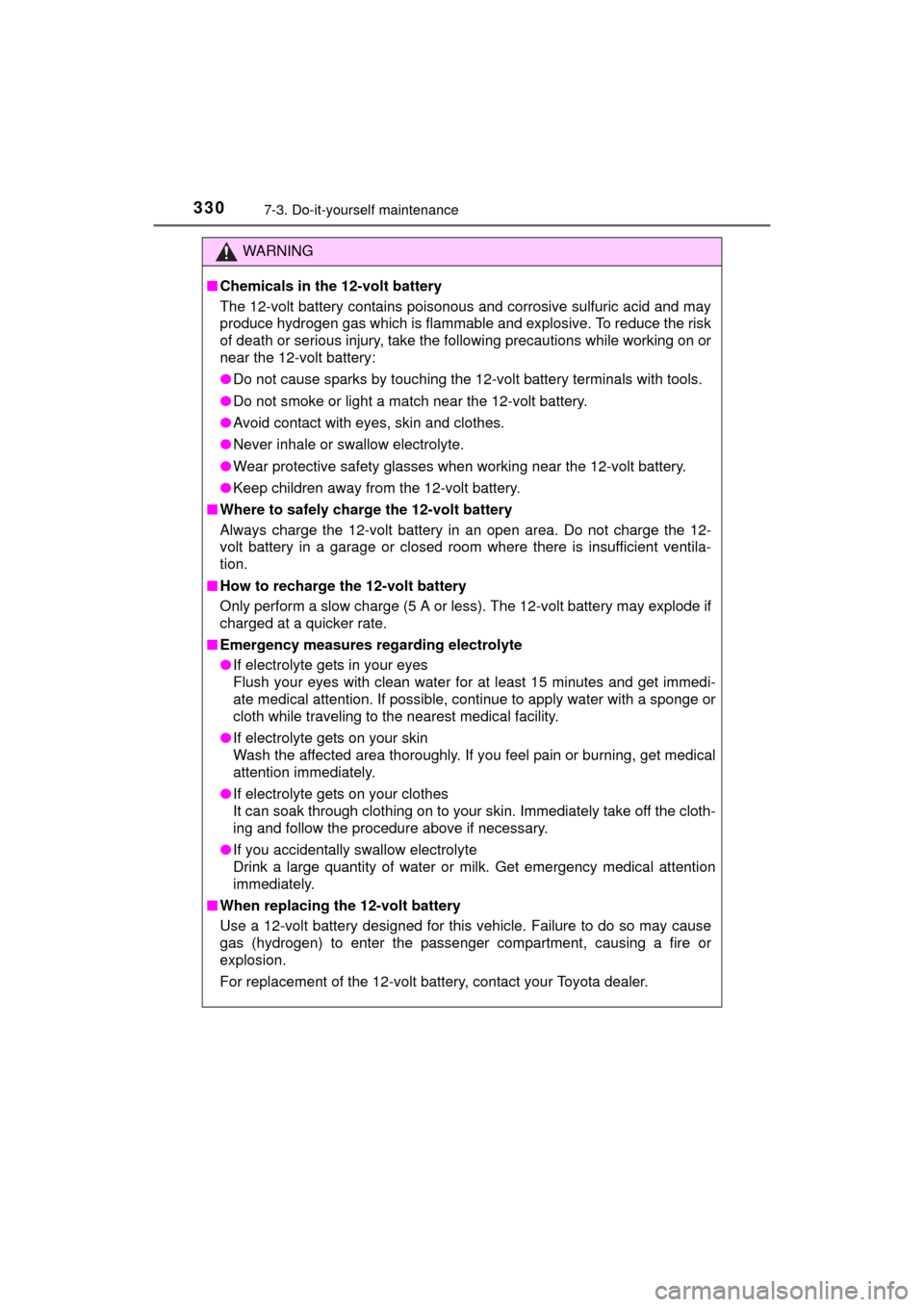
3307-3. Do-it-yourself maintenance
MIRAI_OM_USA_OM62004U
WARNING
■Chemicals in the 12-volt battery
The 12-volt battery contains poisonous and corrosive sulfuric acid and may
produce hydrogen gas which is flammable and explosive. To reduce the risk
of death or serious injury, take the following precautions while working on or
near the 12-volt battery:
●Do not cause sparks by touching the 12-volt battery terminals with tools.
● Do not smoke or light a match near the 12-volt battery.
● Avoid contact with eyes, skin and clothes.
● Never inhale or swallow electrolyte.
● Wear protective safety glasses when working near the 12-volt battery.
● Keep children away from the 12-volt battery.
■ Where to safely charge the 12-volt battery
Always charge the 12-volt battery in an open area. Do not charge the 12-
volt battery in a garage or closed room where there is insufficient ventila-
tion.
■ How to recharge th e 12-volt battery
Only perform a slow charge (5 A or less). The 12-volt battery may explode if
charged at a quicker rate.
■ Emergency measures regarding electrolyte
●If electrolyte gets in your eyes
Flush your eyes with clean water for at least 15 minutes and get immedi-
ate medical attention. If possible, continue to apply water with a sponge or
cloth while traveling to the nearest medical facility.
● If electrolyte gets on your skin
Wash the affected area thoroughly. If you feel pain or burning, get medical
attention immediately.
● If electrolyte gets on your clothes
It can soak through clothing on to your skin. Immediately take off the cloth-
ing and follow the procedure above if necessary.
● If you accidentally swallow electrolyte
Drink a large quantity of water or milk. Get emergency medical attention
immediately.
■ When replacing the 12-volt battery
Use a 12-volt battery designed for this vehicle. Failure to do so may cause
gas (hydrogen) to enter the passenger compartment, causing a fire or
explosion.
For replacement of the 12-volt battery, contact your Toyota dealer.